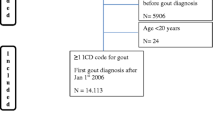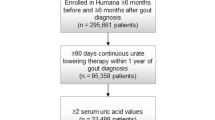Abstract
Objective
To investigate the cause-specific mortality and the possible involved clinical characteristics with increased mortality in a cohort of 700 patients with crystal-proven gout. The cause-specific mortality of gout was compared to the mortality of the general population.
Methods
Patients with arthritis referred for diagnosis were consecutively included in the Gout Arnhem-Liemers Cohort (GOAL). Joint fluid analysis was performed in all patients and only crystal-proven gout patients were included in this study. At inclusion clinical characteristics and laboratory values were collected. At follow-up patients who died were identified. Standardized mortality ratios (SMRs) were calculated for all-causes, cardiovascular diseases, cancer, and infectious diseases using indirect standardization methods for mortality outcomes and compared with the general population. The clinical characteristics of the patients who died were compared with those of the survivors and were analyzed by a logistic regression analysis to identify any associations with mortality.
Results
The study population at inclusion contained 573 (81.9%) men and 127 (18.1%) females with an average age of 62.0 (SD 13.4). During 3500 person-years from inclusion visit till 31 May 2016, in 700 gout patients, 66 deaths (27 cardiovascular deaths, 15 cancer-related deaths, 8 infectious deaths, 16 various other causes) occurred in this cohort. The all-cause standardized mortality ratio in gout patients was 2.21 (95% CI 1.68–2.74). In this cohort, gout patients had a higher SMR for death attributed to cardiovascular diseases (6.75; 95% CI 4.64–8.86), infectious diseases (4.66; 95% CI 1.51–7.82) and cancer (3.58; 95% CI 1.77–5.39). Corrected for confounders high serum uric acid levels (SUA; > 0,56 mmol/L), tophaceous gout, a history of peripheral vascular disease, myocardial infarction, and heart failure at the inclusion visit were associated with increased mortality during follow-up.
Conclusion
Compared to the general population, gout patients have an increased association with all-cause disease mortality, especially attributed to cardiovascular diseases, cancer, and infectious diseases. This association is strongest in hyperuricemic (uric acid levels > 0,56 mmol/l) and tophaceous patients and in those with a history of peripheral vascular disease, myocardial infarction, and heart failure. Preventive measures like treatment of high SUA levels and treatment of cardiovascular risk factors need to be considered and evaluated.



Similar content being viewed by others
References
GBD 2016 Causes of Death Collaborators (2017) Global, regional, and national age-sex specific mortality for 264 causes of death, 1980–2016: a systematic analysis for the global burden of disease study 2016. Lancet 390(10100):1151–1210
Kuo CF, See LC, Luo SF, Ko YS, Lin YS, Hwang JS et al (2010) Gout: an independent risk factor for all-cause and cardiovascular mortality. Rheumatology (Oxford) 49:141–146
Kuo CF, Yu KH, See LC, Chou IJ, Tseng WY, Chang HC, Shen YM, Luo SF (2011) Elevated risk of mortality among gout patients: a comparison with the national population in Taiwan. Joint Bone Spine 78:577–580
Krishnan E, Svendsen K, Neaton JD, Grandits G, Kuller LH, MRFIT Research Group (2008) Long-term cardiovascular mortality among middle-aged men with gout. Arch Intern Med 168(10):1104–1110
Perez-Ruiz F, Martinez-Indart L, Carmona L, Herrero-Beites AM, Pijoan IJ, Krihnan E (2014) Tophaceous gout and high level of hyperuricaemia are both associated with increased risk of mortality in patients with gout. Ann Rheum Dis 73(1):177–182
Kuo CF, Luo SF, See LC, Chou IJ, Fang YF, Yu KH (2012) Increased risk of cancer among gout patients: a nationwide population study. Joint Bone Spine 79(4):375–378
Knoema (2015) World and Regional Statistics. Netherlands—mortality—crude death rate. https://knoema.com
Eurostat (2015) Major causes of death for persons aged 65 and over (standardized date rates per 100.000 inhabitants). https://ec.europa.eu
Disveld IJM, Fransen J, Rongen GA, Kienhorst LBE, Zoakman S, Janssens HJEM et al Crystal-proven gout and characteristic gout severity factors are associated with cardiovascular disease. J Rheumatol 45(6):858–863
Janssens HJ, van de Lisdonk EH, Bor H, van den Hoogen HJ, Janssen M (2003) Gout, just a nasty event or a cardiovascular signal? A study from primary care. Fam Pract 20:413–416
Winnard D, Wright C, Jackson G, Gow P, Kerr A, McLachlan A, Orr-Walker B, Dalbeth N (2012) Gout, diabetes and cardiovascular disease in the Aotearoa New Zealand adult population: co-prevalence and implications for clinical practice. N Z Med J 126(1368):53–64
Zhu Y, Pandya BJ, Choi HK (2012) Comorbidities of gout and hyperuricemia in the US general population: NHANES 2007–2008. Am J Med 125:679–87.e1
Jing J, Kielstein JT, Schultheiss UT, Sitter T, Titze SI, Schaeffner ES, McAdams-DeMarco M, Kronenberg F, Eckardt KU, Kottgen A, for the GCKD Study Investigators, GCKD Study Investigators, Eckardt KU, Titze S, Prokosch HU, Barthlein B, Reis A, Ekici AB, Gefeller O, Hilgers KF, Hubner S, Avendano S, Becker-Grosspitsch D, Hauck N, Seuchter SA, Hausknecht B, Rittmeier M, Weigel A, Beck A, Ganslandt T, Knispel S, Dressel T, Malzer M, Floege J, Eitner F, Schlieper G, Findeisen K, Arweiler E, Ernst S, Unger M, Lipski S, Schaeffner E, Baid-Agrawal S, Petzold K, Schindler R, Kottgen A, Schultheiss U, Meder S, Mitsch E, Reinhard U, Walz G, Haller H, Lorenzen J, Kielstein JT, Otto P, Sommerer C, Follinger C, Zeier M, Wolf G, Busch M, Paul K, Dittrich L, Sitter T, Hilge R, Blank C, Wanner C, Krane V, Schmiedeke D, Toncar S, Cavitt D, Schonowsky K, Borner-Klein A, Kronenberg F, Raschenberger J, Kollerits B, Forer L, Schonherr S, Weissensteiner H, Oefner P, Gronwald W, Zacharias H, Schmid M (2015) Prevalence and correlates of gout in a large cohort of patients with chronic kidney disease: the German chronic kidney disease (GCKD) study. Nephrol Dial Transplant 30(4):613–621
Choi HK, Ford ES, Li C, Curhan G (2007) Prevalence of the metabolic syndrome in patients with gout: the third National Health and nutrition examination survey. Arthritis Rheum 57(1):109–115
Krishnan E (2012) Gout and the risk for incident heart failure and systolic dysfunction. BMJ Open 2(1):e000282
Hueskes BA, Willems FF, Leen AC, Ninaber PA, Westra R, Mantel-Teeuwisse AK et al (2012) A case-control study of determinants for the occurrence of gouty arthritis in heart failure patients. Eur J Heart Fail 14(8):916–921
Kim SY, Guevara JP, Kim KM, Choi HK, Heitjan DF, Albert DA (2009) Hyperuricaemia and risk of stroke: a systemic review and meta-analysis. Arthritis Rheum 61(7):885–892
Kim SY, Guevara JP, Kim KM, Choi HK, Heitjan DF, Albert DA (2010) Hyperuricemia and coronary heart disease: a systemic review and meta-analysis. Arthritis Care Res 62(2):170–180
Zhang Y, Peloquin CE, Dubreuil M, Roddy E, Lu N, Neogi T, Choi HK (2015) Sleep apnea and the risk of incident gout: a population-based, body index-matched cohort study. Arthritis Rheum 67(12):3298–3302
Kienhorst LBE, van Lochem E, Kievit W, Dalbeth M, Merriman ME, Phipps-Green A et al (2015) Gout is a chronic inflammatory disease in which high levels of interleukin 8 (CXCL8) , myeloid-related protein 8/myoloid related protein 14 complex, and an altered proteome associated with diabetes mellitus and cardiovascular disease. Arthritis Rheum 67(12):3303–3313
Cleophas MC, Crisan TO, Joosten LAB (2017) Factors modulating the inflammatory response in acute gouty arthritis. Curr Opin Rheumatol 29(2):163–170
Kienhorst LBE, Janssens H, Radstake T, van Riel P, Jacobs J, van Koolwijk E, van Lochem E, Janssen M (2017) A pilot study of CXCL8 levels in crystal proven gout patients during allopurinol treatment and their association with cardiovascular disease. Joint Bone Spine 84(6):709–713
Fini MA, Elias A, Johnson RJ, Wright RM (2012) Contributions of uric acid to cancer risk, recurrence and mortality. Clin Transl Med 1:16
Vazirpanah N, Kienhorst LBE, Van Lochem E, Wichers C, Rossato M, Shiels PG et al (2017) Patients with gout have short telomeres compared with healthy participants: association of telomere length with flare frequency and cardiovascular disease in gout. Ann Rheum Dis 76(7):1313–1319
Jansen TL, Janssen M (2017) The American College of Physicians and the 2017 guideline for the management of acute and recurrent gout: treat to avoiding symptoms versus treat to target. Clin Rheumatol 36(11):2399–2402
Quaseem A, Harris RP, Forciea MA (2017) Clinical Guidelines Committee of the American College of physicians. Management of acute and recurrent gout: a clinical practice guideline from the American college of physicians. Ann Intern Med 166(1):58–68
Richette P, Doherty M, Pascual E, Barkova V, Becce F, Castañeda-Sanabria J et al (2017) 2016 updated EULAR evidence-based recommendations for the management of gout. Ann Rheum Dis 76(1):29–42
Acknowledgments
We wish to thank E.P. Martens (Statisticor) for the assistance by the statistical calculations.
Author information
Authors and Affiliations
Corresponding author
Ethics declarations
Disclosure
None.
Additional information
Publisher’s note
Springer Nature remains neutral with regard to jurisdictional claims in published maps and institutional affiliations.
Rights and permissions
About this article
Cite this article
Disveld, I.J.M., Zoakman, S., Jansen, T.L.T.A. et al. Crystal-proven gout patients have an increased mortality due to cardiovascular diseases, cancer, and infectious diseases especially when having tophi and/or high serum uric acid levels: a prospective cohort study. Clin Rheumatol 38, 1385–1391 (2019). https://doi.org/10.1007/s10067-019-04520-6
Received:
Revised:
Accepted:
Published:
Issue Date:
DOI: https://doi.org/10.1007/s10067-019-04520-6




